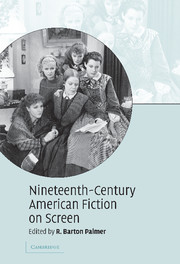Book contents
- Frontmatter
- Contents
- List of illustrations
- Notes on contributors
- Acknowledgments
- Introduction
- 1 A very American fable: the making of a Mohicans adaptation
- 2 Romancing the letter: screening a Hawthorne classic
- 3 The movies in the Rue Morgue: adapting Edgar Allan Poe for the screen
- 4 Readapting Uncle Tom's Cabin
- 5 Screening authorship: Little Women on screen 1933–1994
- 6 Melville's Moby-Dick and Hollywood
- 7 Screening male sentimental power in Ben-Hur
- 8 John Huston's The Red Badge of Courage
- 9 Translating Daisy Miller
- 10 Jane Campion's The Portrait of a Lady
- 11 The Europeans – and the Americans
- 12 Sister Carrie becomes Carrie
- 13 Hollywood and The Sea-Wolf
- 14 An untypical typicality: screening Owen Wister's The Virginian
- Filmography
- Index
8 - John Huston's The Red Badge of Courage
Published online by Cambridge University Press: 22 December 2009
- Frontmatter
- Contents
- List of illustrations
- Notes on contributors
- Acknowledgments
- Introduction
- 1 A very American fable: the making of a Mohicans adaptation
- 2 Romancing the letter: screening a Hawthorne classic
- 3 The movies in the Rue Morgue: adapting Edgar Allan Poe for the screen
- 4 Readapting Uncle Tom's Cabin
- 5 Screening authorship: Little Women on screen 1933–1994
- 6 Melville's Moby-Dick and Hollywood
- 7 Screening male sentimental power in Ben-Hur
- 8 John Huston's The Red Badge of Courage
- 9 Translating Daisy Miller
- 10 Jane Campion's The Portrait of a Lady
- 11 The Europeans – and the Americans
- 12 Sister Carrie becomes Carrie
- 13 Hollywood and The Sea-Wolf
- 14 An untypical typicality: screening Owen Wister's The Virginian
- Filmography
- Index
Summary
The challenges and processes of adaptation both resemble each other and differ from each other. On the one hand, all film adaptations of novels involve a transfer from the medium of verbal prose fiction to that of film. It is important to remember that this is a radical form of transfer – a “translation into film language,” as the Russian formalist Boris Eikhenbaum put it as early as 1926 – regardless of what kind of adaptation is being made. On the other hand, one and the same literary text can, of course, be adapted in different ways according to the director's ideas, as regards both filmmaking in general and adaptation in particular. Moreover, the director's adaptation of a literary text is unavoidably marked by his or her response to, and interpretation of, that text; and as we all know, such interpretations can vary very considerably. As Robert Stam has shown, the main issue here is not an adaptation's “fidelity” to a literary text but rather a complex form of dialogue between two different media. Even though it is possible to consider the phenomenon and practice of adaptation as a translation from one medium to another, there is no “transferable core: a single novelistic text comprises a series of verbal signals that can generate a plethora of possible readings, including even readings of the narrative itself.”
- Type
- Chapter
- Information
- Nineteenth-Century American Fiction on Screen , pp. 133 - 145Publisher: Cambridge University PressPrint publication year: 2007
- 1
- Cited by



